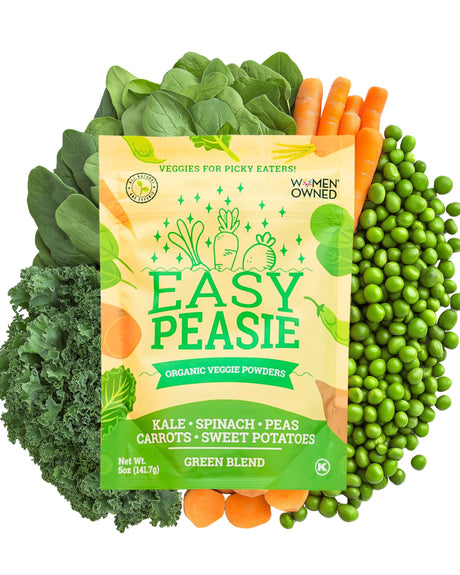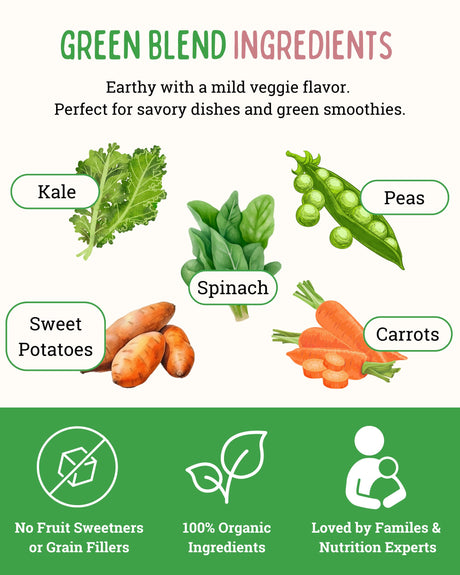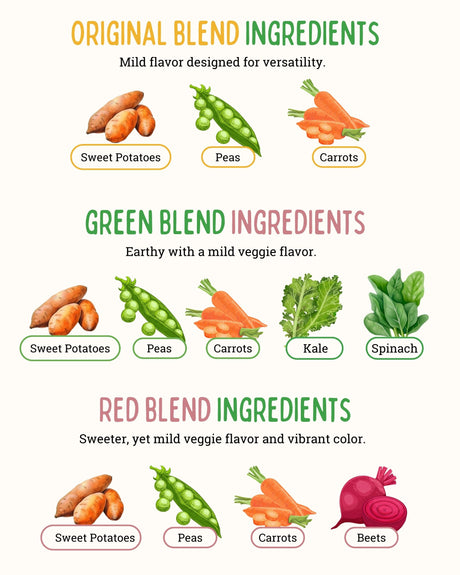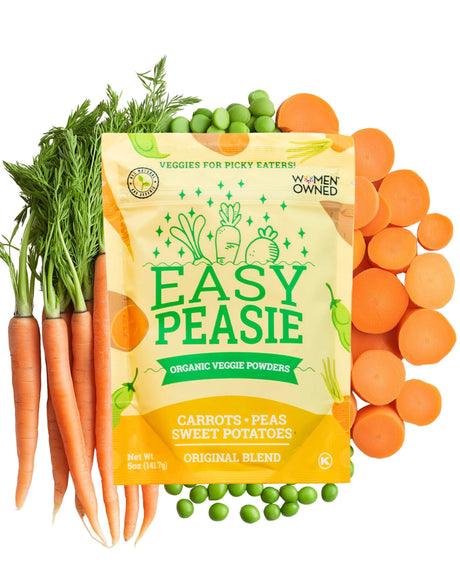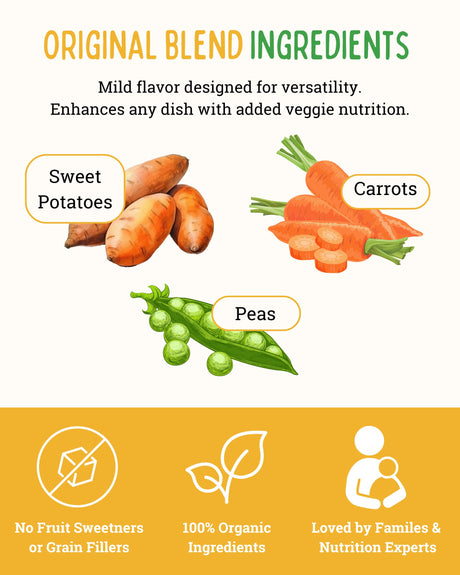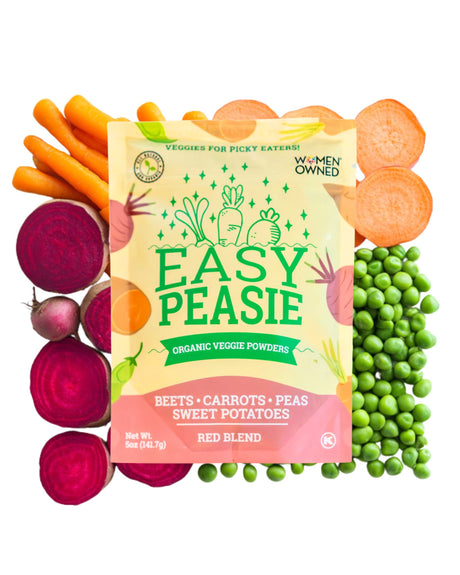Nutrition at Every Stage
From tiny toddlers taking their first bites of solid foods to teenagers fueling their busy, active lives, nutrition is the backbone of healthy growth and development. As kids grow, their nutritional needs shift dramatically, making it essential for parents to adjust meals accordingly.
The right nutrients at the right time can help support everything from brain development to strong bones and a healthy immune system. Whether you're dealing with a picky eater or a teenager with a bottomless appetite, understanding these evolving needs ensures your kids get the best start in life.
In this blog, we’ll dive into how to meet your child’s nutritional needs from toddlers to teens. We’ll cover essential nutrients at each stage, tips for feeding picky eaters, and practical strategies for creating balanced meals that cater to the entire family. Whether you’re navigating snack-time for a toddler or fueling a teen athlete, we’ve got you covered with easy, actionable tips to bridge the nutritional gaps as your child grows. Let’s explore how to keep your family’s meals balanced and nutritious at every age!
Nutritional Needs for Toddlers and Teens
Toddlers’ Nutritional Needs
Toddlers may be small, but their nutritional needs pack a punch! At this stage, essential nutrients like calcium, iron, and healthy fats are crucial for brain development, strong bones, and overall growth. Because toddlers tend to have smaller appetites, it’s important to focus on nutrient-dense meals. Think whole milk, yogurt, and iron-rich foods like beans or lean meats to fuel their little bodies.
Nutritional Needs for Teens
As kids hit their teenage years, their nutritional needs shift into high gear, especially during growth spurts. Protein becomes even more important to support muscle development, while calcium and iron are essential for bone health and energy. Balanced meals with a mix of lean proteins, fruits, veggies, and whole grains will help teens power through their active schedules—whether they’re hitting the books or the basketball court!
How Needs Evolve from Toddler to Teen
From the tiny meals of toddlers to the big appetites of teens, one thing is clear: children’s nutritional needs evolve as they grow. Toddlers require smaller, frequent meals rich in key nutrients, while teens need more calories and specific nutrients like protein, iron, and calcium. Parents should adjust portion sizes, meal frequency, and food choices to match the changing needs of their growing children.
Balanced Meals for Kids and Teens
Creating Balanced Meals for All Ages
Whether you’re prepping a plate for a toddler or a teen, balance is key. A well-rounded meal should include a variety of fruits, veggies, whole grains, lean proteins, and healthy fats.
For younger kids, think finger-friendly foods like colorful carrot sticks or mini sandwiches.
For teens, bigger portions of hearty meals like grain bowls or lean protein-packed wraps can keep them satisfied and fueled throughout the day.
Portion Sizes for Different Age Groups
Portion sizes vary as kids grow, but a good rule of thumb is to start small for toddlers and increase servings as they hit school-age and beyond. For toddlers, a tablespoon of each food per year of age is a simple guide. For teens, who often have bigger appetites, don’t be afraid to offer larger portions of protein and whole grains to keep them full and energized.
Healthy Eating Tips for Growing Children
One of the best ways to encourage healthy eating is to make meals colorful and fun. Introduce a rainbow of veggies, lean proteins, and whole grains in ways that appeal to kids—like veggie wraps or fruit kabobs. Offering variety at every meal keeps things interesting and ensures they’re getting a wide range of essential nutrients.
Essential Nutrients for Child Development
Key Nutrients for Toddlers
For toddlers, the right nutrients are the building blocks of growth. Calcium is crucial for strong bone development, while iron is essential for cognitive development and overall energy.
Don’t forget healthy fats—they’re vital for brain growth, and you can find them in foods like avocados, nuts, and full-fat dairy.
Key Nutrients for Teens
As teens grow, their bodies need an extra dose of key nutrients to support rapid changes. Protein is essential for muscle growth and repair, especially during those teenage growth spurts. Calcium remains critical for maintaining bone strength, and iron, particularly for adolescent girls, is important for maintaining energy levels and supporting red blood cell production.
Importance of Vitamins and Minerals
Vitamins and minerals play a supporting role in keeping children healthy at every stage. Vitamin D helps the body absorb calcium, Vitamin C boosts the immune system, and Vitamin A supports eye health and growth. Ensuring your kids get enough of these vitamins through a varied diet of fruits, veggies, and fortified foods can make all the difference in their long-term health.
Feeding Picky Eaters
Common Challenges with Picky Eaters
Feeding picky eaters can feel like a never-ending battle. Many kids go through phases of refusing new or unfamiliar foods, which often starts in toddlerhood and can carry through to adolescence (and even adulthood). From texture issues to plain stubbornness, picky eating is a challenge nearly all parents face at some point.
Tips for Encouraging Healthy Eating in Picky Eaters
It’s all about strategy! One way to sneak in those veggies is by blending them into smoothies or incorporating them into sauces. Patience is key here—consistency without pressure can help ease the tension around mealtime. Over time, repeated exposure to a variety of foods encourages kids to try them.
Creative Ways to Serve Nutritious Foods
Presentation matters, especially for little ones! Fun and creative food presentations, like using bento boxes or arranging food in rainbow colors, can make even the simplest meals exciting. Think carrot sticks that look like stars or a fruit plate that resembles a smiley face—making healthy food fun can encourage even the pickiest eaters to take a bite.
Age-Specific Nutrition for Kids
Toddlers (Ages 1-3)
Toddlers have tiny tummies but big energy needs, so frequent, nutrient-dense snacks are the way to go! Think of meals like bite-sized fruit, cheese cubes, or small servings of whole grains to fuel their development. At this stage, small portions packed with essential nutrients like iron, calcium, and healthy fats are crucial to support their rapid growth.
School-Aged Kids (Ages 4-12)
As children enter school age, their bodies and minds are developing steadily. It's important to introduce a wide variety of food groups—grains, fruits, vegetables, proteins, and dairy—to ensure they're getting everything they need. Balanced meals packed with fiber, protein, and vitamins will help support their energy levels for learning and playtime.
Teenagers (Ages 13+)
For teens, physical growth and hormonal changes require extra calories and protein. Whether they’re going through growth spurts or leading active lifestyles, they need a diet rich in calcium, iron, and protein to maintain energy and support muscle development. Keep healthy, filling snacks like nuts, yogurt, and lean meats readily available to satisfy those growing appetites.
How to Transition Meals as Kids Grow
As kids grow, their appetites and preferences shift. Transitioning from toddler-sized portions to full family meals can be made easier by offering a mix of familiar and new foods.
Start by introducing smaller portions of family meals to toddlers and gradually increase serving sizes as they grow. Don’t be afraid to adapt family recipes to suit everyone’s nutritional needs—like adding extra veggies or reducing salt for younger kids.
Planning Balanced Family Meals
Family meals should cater to everyone at the table, from toddlers to teens. Start with flexible recipes like tacos, pasta dishes, or stir-fries, which allow each family member to customize their portions and add-ons. This way, you can ensure that younger children get the right portion sizes while teens can fill up on extra proteins and carbs to match their needs.
Prepping Meals for Busy Schedules
Busy weeknights don’t have to mean skipping nutrition! Batch cooking can be a lifesaver—prep ingredients like grilled chicken, roasted veggies, and cooked grains ahead of time to mix and match throughout the week.
Healthy snacks like pre-sliced fruits, yogurt, and veggie sticks are easy to grab for kids of all ages, ensuring they’re fueling up on something nutritious, even on the go.
Creating Family Meal Plans
A weekly meal plan is a great tool for ensuring everyone in the family is getting the nutrients they need. Include meals that are easy to adapt for different age groups—like veggie-loaded casseroles or build-your-own salad nights. Planning ahead allows you to accommodate picky eaters, keep everyone’s tastes in mind, and make sure your grocery list covers it all.
Preventing Nutrient Deficiencies in Kids
Common Nutrient Deficiencies in Children
Iron, calcium, and vitamin D are some of the most common nutrient deficiencies found in children. Iron helps deliver oxygen throughout the body, while calcium is crucial for strong bones and teeth. Vitamin D supports both bone health and the immune system.
To prevent these deficiencies, it’s essential to provide meals rich in iron from sources like lean meats and leafy greens, calcium from dairy products or fortified alternatives, and vitamin D from exposure to sunlight and fortified foods.
How to Ensure Kids Get Enough Vitamins and Minerals
Ensuring your kids meet their daily vitamin and mineral needs can be simple with a few practical steps. Offer a colorful variety of fruits, vegetables, and whole grains to maximize nutrient intake. For kids who might resist eating certain foods, smoothies or veggie-packed sauces are a great way to sneak in extra nutrients. If necessary, consult a healthcare provider to explore supplements that can fill in any nutritional gaps.
Importance of Regular Health Check-ups
Routine pediatric check-ups are key to monitoring your child’s growth and nutritional status. These visits allow healthcare providers to track weight, height, and development while addressing any concerns about nutrient deficiencies early. Regular check-ups ensure your child stays on track with their growth milestones and gets the right support if any nutritional issues arise.
Bridging Nutrition Gaps in Growing Children
Importance of Calcium and Protein for Kids
During periods of rapid growth, like adolescence, your child’s need for calcium and protein spikes. Calcium supports the development of strong bones and teeth, which is especially important as kids grow taller.
Protein helps build and repair muscles, keeping kids strong and energized for physical activities. Including dairy, lean meats, beans, and nuts in their daily meals is a great way to meet these nutritional needs.
How to Address Nutritional Gaps
If you’re concerned about nutritional gaps, there are practical solutions to help bridge them. Fortified foods like breakfast cereals, plant-based milk, and juices can provide essential vitamins like B12, vitamin D, and iron.
For picky eaters, offering a variety of food textures and flavors can encourage them to try new, nutrient-dense options. Meal prepping in advance is also a great way to ensure there’s always a healthy option on hand.
Using Supplements When Necessary
In some cases, it may be helpful to introduce supplements into your child’s meals. If your child struggles to get enough iron, calcium, or other vital nutrients through food alone, supplements can be a good option. Always consult your pediatrician before adding supplements to ensure they’re age-appropriate and provide the correct dosage for your child’s needs.
Summary
From toddler to teen, children have evolving nutritional needs. By providing balanced meals rich in essential nutrients like calcium, iron, and protein, you’re supporting your child’s physical and cognitive development at every stage. With the right foods, regular health check-ups, and attention to potential nutrient gaps, parents can set their children up for long-term health.
Plan Balanced Meals
Planning meals that cater to all age groups in your family doesn’t have to be overwhelming.
By focusing on whole foods and nutrient-rich ingredients, you can create delicious and healthy meals that meet the needs of toddlers, school-aged kids, and teens alike. Involving your kids in the meal planning process can even make them more excited about healthy eating!
Ready to take charge of your family’s nutrition? Explore resources for meal planning, healthy recipes, and nutrition tips for kids of all ages. Don’t forget to share your favorite strategies and recipes for bridging nutritional gaps in the comments, and follow Easy Peasie on social media (Facebook, Instagram, and YouTube) for more family-friendly information!


